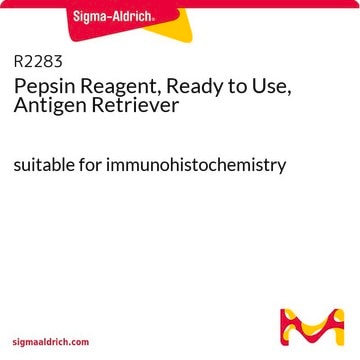P6887
Pepsin from porcine gastric mucosa
lyophilized powder, ≥3,200 units/mg protein
Synonym(s):
Pepsin A, Pepsin from hog stomach
About This Item
Recommended Products
biological source
Porcine gastric mucosa
grade
Proteomics Grade
form
lyophilized powder
specific activity
≥3,200 units/mg protein
mol wt
35 kDa
impurities
salt, essentially free
color
white to off-white
solubility
deionized water: soluble 10 mg/mL
10 mM HCl: soluble 4.0 mg/mL (Cold)
UniProt accession no.
application(s)
diagnostic assay manufacturing
shipped in
wet ice
storage temp.
−20°C
Gene Information
pig ... LOC396892(396892)
Looking for similar products? Visit Product Comparison Guide
Related Categories
Application
Biochem/physiol Actions
Unit Definition
Analysis Note
Other Notes
inhibitor
Signal Word
Danger
Hazard Statements
Precautionary Statements
Hazard Classifications
Eye Irrit. 2 - Resp. Sens. 1 - Skin Irrit. 2 - STOT SE 3
Target Organs
Respiratory system
Storage Class Code
11 - Combustible Solids
WGK
WGK 1
Flash Point(F)
Not applicable
Flash Point(C)
Not applicable
Personal Protective Equipment
Regulatory Listings
Regulatory Listings are mainly provided for chemical products. Only limited information can be provided here for non-chemical products. No entry means none of the components are listed. It is the user’s obligation to ensure the safe and legal use of the product.
JAN Code
P6887-VAR:
P6887-5G:
P6887-BULK:
P6887-250MG:
P6887-1G:
P6887-250G:
P6887-10G:
Certificates of Analysis (COA)
Search for Certificates of Analysis (COA) by entering the products Lot/Batch Number. Lot and Batch Numbers can be found on a product’s label following the words ‘Lot’ or ‘Batch’.
Already Own This Product?
Find documentation for the products that you have recently purchased in the Document Library.
Customers Also Viewed
Articles
Antibody fragmentation with our pepsin digestion protocol for IgG antibody fragmentation and preparation of F(ab’).
Available Fluorescent in situ hybridization (FISH) procedures, reagents and equipment.
Protocols
This procedure may be used for determination of Pepsin activity using hemoglobin as the substrate. It is a spectrophotometric stop rate determination.
Our team of scientists has experience in all areas of research including Life Science, Material Science, Chemical Synthesis, Chromatography, Analytical and many others.
Contact Technical Service









